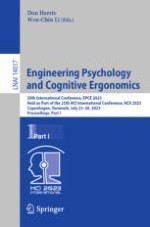This two-volume set LNCS 14017 - 14018 constitutes the thoroughly refereed proceedings of the 20th International Conference on Engineering Psychology and Cognitive Ergonomics, EPCE 2023, held as part of HCI International 2023 which took place in Copenhagen, Denmark, during July 23-28, 2023.
A total of 1578 papers and 396 posters have been accepted for publication in the HCII 2023 proceedings from a total of 7472 submissions.
The papers included in the HCII-EPCE volume set were organized in topical sections as follows:
Part I: Stress, fatigue, and mental workload; human performance and error management; resilience and performance in demanding contexts.
Part II: Human factors in aviation; human factors in operations management; human-centered design of autonomous systems.
